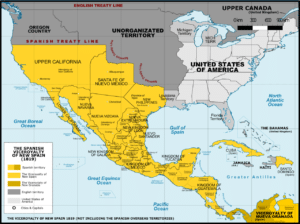
The territory became part of the Spanish Empire under the name of New Spain in 1535. Mexico City was systematically rebuilt by Cortés following the Fall of Tenochtitlan in 1521. Much of the identity, traditions and architecture of Mexico developed during the 300-year colonial period from 1521 to independence in 1821.
Viceroyalty of New Spain (1521–1821):
The 1521 capture Tenochtitlan and immediate founding of the Spanish capital Mexico City on its ruins was the beginning of a 300-year-long colonial era during which Mexico was known as Nueva España (New Spain). The Kingdom of New Spain was created from the remnants of the Aztec empire. The two pillars of Spanish rule were the State and the Roman Catholic Church, both under the authority of the Spanish crown. In 1493 the pope had granted sweeping powers to the Spanish crown, with the proviso that the crown spread Christianity in its new realms. In 1524, King Charles I created the Council of the Indies based in Spain to oversee State power its overseas territories; in New Spain the crown established a high court in Mexico City, the Real Audiencia, and then in 1535 created the viceroyalty.

The viceroy was highest official of the State. In the religious sphere, the diocese of Mexico was created in 1530 and elevated to the Archdiocese of Mexico in 1546, with the archbishop as the head of the ecclesiastical hierarchy, overseeing Roman Catholic clergy. Castilian Spanish was the language of rulers. The Catholic faith the only one permitted, with non-Catholics (Jews and Protestants) and Catholics (excluding Indians) holding unorthodox views being subject to the Mexican Inquisition, established in 1571.
In the first half-century of Spanish rule, a network of Spanish cities was created, sometimes on pre-Hispanic sites. The capital Mexico City was and remains the premier city. Cities and towns were hubs of civil officials, ecclesiastics, business, Spanish elites, and mixed-race and indigenous artisans and workers. When deposits of silver were discovered in sparsely populated northern Mexico, far from the dense populations of central Mexico, the Spanish secured the region against fiercely resistant indigenous Chichimecas. The Viceroyalty at its greatest extent included the territories of modern Mexico, Central America as far south as Costa Rica, and the western United States. The Viceregal capital Mexico City also administrated the Spanish West Indies (the Caribbean), the Spanish East Indies (that is, the Philippines), and Spanish Florida. In 1819, the Spain signed the Adams-Onís Treaty with the United States, setting New Spain’s northern boundary.

The rich deposits of silver, particularly in Zacatecas and Guanajuato, resulted in silver extraction dominating the economy of New Spain. Taxes on silver production became a major source of income for Spain. Other important industries were the haciendas and mercantile activities in the main cities and ports.
